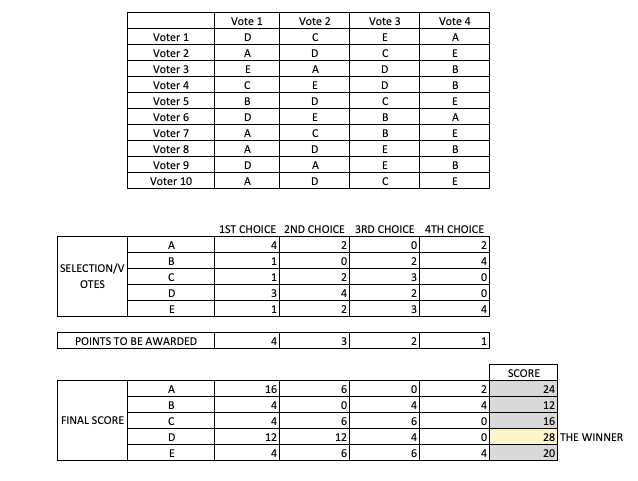
Decision making can be complex. Especially in a team environment when everyone could be pulling in different directions. All too often teams can be led by the person with the loudest voice/strongest personality who believes they’re right all the time and the rest of the team, wanting an easy life, are often reluctant to raise objections.
However, this can be mitigated. Businesses can utilize various decision-making processes including:
- Voting systems (first past the post)
- Letting the leadership/management decide
- Consensus-based decision making
All of these systems have pro’s/Con’s (some more than others.)
When it comes to point 3 (utilizing a consensus-based process), this can be difficult to implement.
Luckily there is a tried and tested method that can be used – the Borda Count method.
The Borda count method is a voting system that utilizes consensus rather than majority selection methods. It originates from an election process in which candidates are ranked by voters in preferential order. The process is designed to choose candidates through consensus, rather than in typical election methods, where one winner is selected by the majority.
Each candidate is given a series of points depending on their selection (e.g. first choice gets more than the fifth choice). Votes are counted and the candidate with the highest points tally overall wins.
This method can be easily applied to a business context, described as the “modified Borda count method”.
How consensus-based voting systems (like Borda count) can help in decision making
While Teams typically strive for consensus the actual process can be surprisingly challenging.
All too often the teams will sit in a room and debate a way forward until a consensus is arrived at. That can sometimes override the ability to review alternatives or properly question ideas put forward.
All too often you find the loudest voice in the room taking control and driving the team in a particular direction (especially in high-pressure situations).
The loudest voice doesn’t always know best and this can have disastrous consequences if the wrong way forward is selected and therefore having an effective decision-making tool is crucial where all voices are heard and choices evaluated equally. There are further reasons to drive an effective decision-making process eg.
- It avoids complacency
- It mitigates peer pressure
- It provides an effective engagement
- It allows each option to be assessed on it’s own merits
Example Borda count method.
In a typical scenario (first passed the post) you might have several choices being reviewed with your team then voting for their preferred choice.
Let’s have a look at this in practice.
Let’s say you have 5 choices and you have 10 people voting. Ideally, you would have a clear winner (e.g. Choice 1 getting the most votes).
| Choice | Votes |
| Choice 1 | 3 |
| Choice 2 | 2 |
| Choice 3 | 2 |
| Choice 4 | 1 |
| Choice 5 | 1 |
Using consensus-based voting
The Borda count method uses a points-based system for each choice based on the placement. This helps to avoid strong/persuasive individuals taking over and provides everyone a voice – in our example we might give points for the top 4 places – so
| Choice | Points |
| First Choice | 4 |
| Second Choice | 3 |
| Third Choice | 2 |
| Fourth Choice | 1 |
| Fifth Choice | 0 |
So If I’m a voter I would make four choices from the options presented, when counted my first choice would score 4 points, my second 3 and so on.
Let’s look at an example using the Borda Count method:
We have
- 10 voters
- 5 choices (represented by A-E in our example)
- Each voter picks a 1st, 2nd, 3rd, 4th choice
- 1st choice scores 4 points, Second 3, Third 2 and fourth
Here’s how our voters voted together with how the points are calculated and a result.

In our example Choice D won as it scored more points overall than other choices (in particular Choice A which was selected first more than Choice D but finished 2nd overall).
Problems with consensus-based systems
Just by deploying a consensus-based decision-making process doesn’t mean that problems are fully mitigated. Decisions can still be incorrect. To further support consensus decision making you can follow up Borda count methods by:
- Reviewing decisions utilizing impact assessment tools to evaluate the choice made
- Utilize project steering groups to externally validate decisions
- Test/Trial decisions before ratifying/deploying
- Introduce formal group techniques and decision-making tools, such as the ones listed above, to avoid Groupthink in the future.
So there you have it, how to use the Borda count method for consensus-based decision making – hope you have found this useful. If you’ve got feedback on the process we’d love to hear from you either in the comments section below or via Twitter.